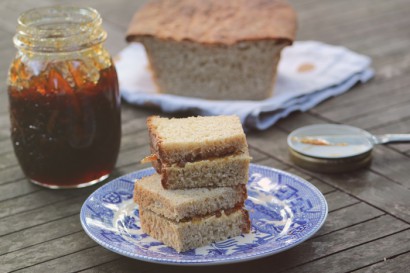No Reviews
You must be logged in to post a review.

This marmalade is best enjoyed on warm, buttery toast, or on sandwiches tucked underneath your hat (in the style of Paddington the Bear)!
1. Wash the fruit well.
2. Cut the fruit in half and juice it using a standard plastic juicer (the old-fashioned plastic citrus juicer kind, not the new-fangled machine ones). Put to the side any pips and flesh which fall into the juicer as your go.
3. Place your muslin into a bowl and put the pips and flesh you collected inside. Cut the fruit into quarters and use a serrated knife and your fingers to scrape the rest of the pips and flesh into the muslin (I found it easiest to start off using a knife, and finish the job by pulling out all the flesh with my fingers). Don’t worry if you miss some, though. Any remaining flesh on the peel will melt away during the cooking process.
4. Cut the fruit into quarters and then cut each quarter of peel into thin shreds. Add any additional flesh to the pile on the muslin as you go.
5. Place the shredded peel into a large, heavy-duty pot. Use the string to tie the muslin into a bag, with the pips and flesh inside, and add that into the pot as well. Pour the water into the pot, bring the mixture to a boil then lower heat to a simmer. Simmer uncovered, for about two hours, until the peel is soft.
6. Take the pot off the heat and remove the muslin bag. Place it in a bowl to cool.
7. Once the muslin bag is cool enough to handle, bring the marmalade mixture back to a low simmer, then pour in the sugar, stirring until completely dissolved. Squeeze the muslin bag over the pot, as hard as you can. Lots of gloopy juice should come out. This contains the pectin, which helps set the marmalade, so squeeze as much from the muslin as you can. Stir this in, then increase the heat to high and put a few plates in the freezer. You might want to preheat your oven to 150º C at this point too.
8. Bring the marmalade to a rolling boil and. After five minutes, start testing whether the marmalade has reached its setting point, which is about 105º C. A sugar thermometer is a big help here. To check whether the marmalade has set, place a scant teaspoon onto a cold plate, and then return to the fridge to cool for a few minutes. If the skin of marmalade becomes crinkly when you push it with your finger, it is set. If not, continue cooking your marmalade, checking every five minutes or so until it does set. It took my marmalade about 25 minutes to set, although it can happen much quicker than this.
9. Remove the marmalade from the heat, and allow it to settle for 15 minutes or so.
10. While the marmalade is settling, you can sterilize your jars: Wash the jars in warm soapy water, then dry with a towel and place in the oven to finish drying completely. To sterilize the lids, place them in boiling water for a few minutes, then allow to dry completely.
11. Remove any scum from the top of the marmalade with a spoon, then pour the marmalade into the jars and seal them while the jars are still hot.
12. Label the jars and then store them in a dry, dark and cool place.
No Comments
Leave a Comment!
You must be logged in to post a comment.